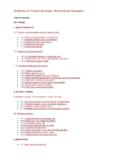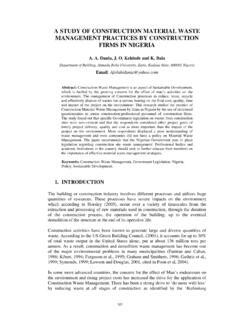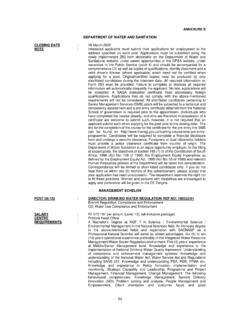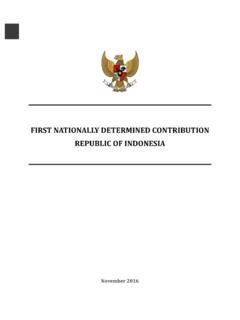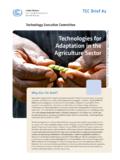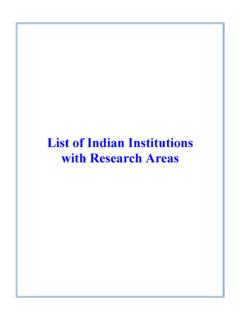Transcription of Sample Goals and Objectives - Oregon
1 Sample Goals and Objectives The following Sample Goals and Objectives can serve as a starting point for preparing or reviewing existing community Goals and Objectives for a transportation system plan. Plan preparers can also use the OR-Plan tool to find State policies and strategies related to specific issues, modes or plans. The goal and objective statements are intended to be comprehensive, covering all aspects of an integrated, multi-modal transportation system, but they are not exhaustive. The language presented reflects best practices and will be generally applicable as is ; some Goals and Objectives will require more specificity in order to be meaningful to a specific community.
2 Also note that the Goals and Objectives shown here do not need to be included in all transportation system plans. Some Objectives are more specific to a geography city, county, and/or region ( , within an MPO, coastal, urban, or rural environments, etc.). Given the close relationship between topic areas and the associated goal statements, Objectives can often relate to more than goal and can be reasonably housed under two or more different Goals ( environmental and sustainability Objectives ). Thoughtful modifications to the wording of an objective can change the emphasis, thereby distinguishing between Objectives , ensuring that language matches the intent of the goal, and avoiding duplication.
3 Bracketed text indicates where language is applicable ( , city or county) or that text will need to be replaced or updated ( , inserting the jurisdiction name). 1. Communication, Collaboration and Coordination Goal: Develop and maintain a Transportation System Plan that is consistent with the Goals and Objectives of the City, [applicable] County, and the state. [City] Develop a transportation system that is consistent with the [jurisdiction s] adopted comprehensive plan and the adopted plans of state, regional, and neighboring jurisdictions. [County] Objectives : A.
4 Ensure consistency with state, regional and local planning rules, regulations, and standards. B. Ensure that land use, financial, and environmental planning efforts are coordinated in order to better prioritize and fund strategic transportation investments. C. Coordinate land use and transportation decisions to efficiently use public infrastructure investments to: a. Maintain the mobility and safety of the roadway system b. Foster efficient development patterns c. Encourage the availability and use of transportation options such as biking, walking and taking transit d.
5 Plan for efficient and safe emergency response and evacuation needs D. Coordinate with [applicable adjacent jurisdictions and county/counties] and the Oregon Department of Transportation to implement system management and operations strategies on arterials and highways. E. Coordinate with [applicable the public transit providers] to strengthen the efficiency and performance of the [jurisdiction] transit network and to support the multimodal system. F. Coordinate regional project development and implementation with local jurisdictions.
6 [County] G. Incorporate needs and projects identified in other state, regional, or local plans. 2. Safety and Security Goal: Provide a transportation system that is safe and secure for all transportation modes and for people of all ability levels. Objectives : A. Address existing safety issues at locations with a history of fatal and severe injury vehicle, bicycle- and/or pedestrian-related crashes. B. Assess and improve locations with a high risk of future fatal and severe injuries, with a particular focus on vulnerable road users.
7 C. Reduce the potential for conflicts by providing separation between travel modes. D. Manage access to transportation facilities consistent with their applicable classification to reduce and separate conflicts and provide reasonable access to land uses. [Also a Mobility objective.] E. Improve the safety of rail crossings. F. Identify and improve safe crossings for vehicles, bicycles and pedestrians across highways and major arterials. G. Assess options to reduce traffic volumes and speeds near schools, transit stops, and other essential destinations.
8 A. [detailed/specific example] Work with the school district and educational institutions to identify and implement circulation and access patterns to and around schools that are safe for pedestrians and bicyclists, as well as people in cars and buses. b. [detailed/specific example] Implement the Safe Routes to Schools Plan recommendations. H. Incorporate traffic calming measures to improve safety for pedestrians, bicyclists, and vehicles. I. Support technology applications that improve safety ( speed cameras, red light cameras).
9 J. Improve personal security on public facilities and services ( , street lighting and design, and surveillance/patrols around transit). K. Install amenities ( , chirpers) that meet Americans with Disabilities Act requirements at signalized pedestrian crossings to improve safety of vulnerable populations. L. Improve the visibility of transportation users in constrained areas, such as on hills and blind curves. M. Educate travelers on the rules of the road to promote understanding of legal rights and responsibilities and how all modes and users can safely and courteously interact with each other.
10 N. Provide education and outreach to school children about walking and biking options and how to safely use those modes. O. Develop safe walking and biking connections to schools. P. Maintain and enhance lifeline and evacuation routes in coordination with local, regional, state and private entities. Q. Engage law enforcement, emergency service providers, and public health professionals in safety planning to increase public safety and security. 3. Health Goal: Provide a transportation system that enhances the health of residents and users.









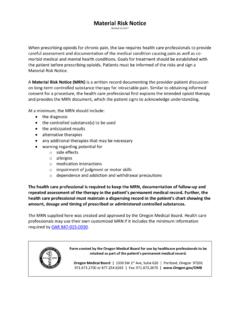
![National Water Act [No. 36 of 1998] - Energy](/cache/preview/a/6/8/e/8/1/4/b/thumb-a68e814b4d9bccc74f62a3a6b561e382.jpg)
